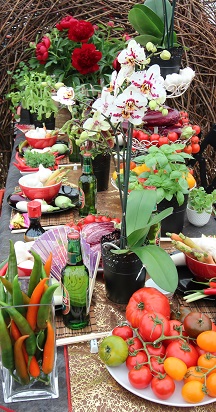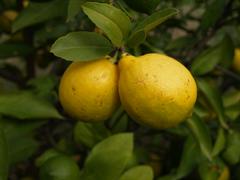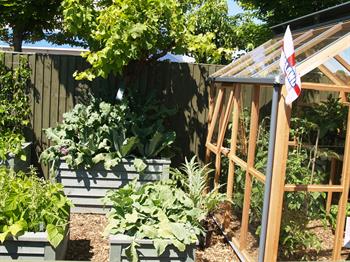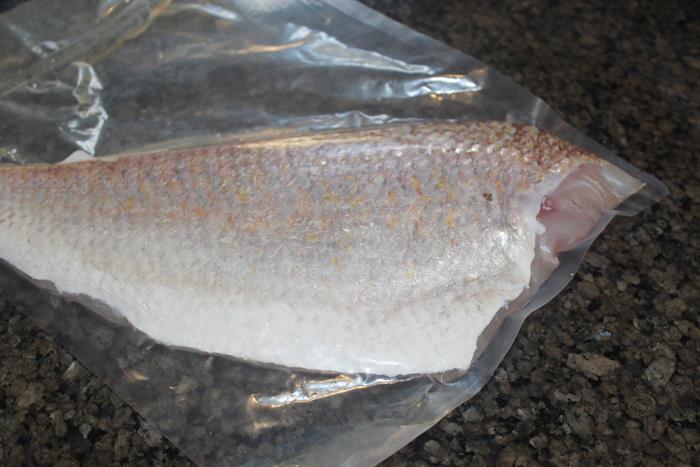Study, Learn, and Put Self Sufficiency into Practice at Home or at Work
- Live a More Sustainable Life or Help others Improve their Level of Self Sufficiency
- Reduce your reliance on money, a secure job and a regular income
 It can be a life changing and liberating experience to learn how to provide for your own needs and the needs of your family.
It can be a life changing and liberating experience to learn how to provide for your own needs and the needs of your family.
Self sufficiency is not an "all or nothing" proposition; and in reality, we will never be totally independent for one reason: it is in our nature to be social, and we all need to interact with other humans in order to be psychologically fulfilled. Many of the tutors in this course have however shown through their own lives that it is possible to grow your own food, produce your own energy and make many of the things you need in your day to day living.
When you study Self Sufficiency through ACS you are learning from people who are both academically trained (in things like farming) and who are applying aspects of self sufficiency to their own daily lives.
Why do this course?
- Become more self sufficient in your own life
- Help others become self sufficient, perhaps teaching or maybe by developing a "green" industry business.
Course Content and Structure
Core Modules
These modules provide foundation knowledge for the Certificate In Self Sufficiency.
Elective Modules
In addition to the core modules, students study any 4 of the following 10 modules.
Alternative Energy VSS102
Herb Culture BHT114
Mud Brick Construction ASS103
Starting A Small Business VBS101
Permaculture Systems BHT201

Poultry BAG208
Sustainable Agriculture BAG215
Advanced Permaculture BHT301
Bush Tucker Plants BHT328
Berry Production
Organic Plant Culture BHT302
Fruit Production
Content of Core Modules
Self Sufficiency I covers ten lessons which develop your understanding of self sufficiency, food and nutrition, and making the right decisions about changes in lifestyle; as well as showing you how to do a whole range of practical things such as mud brick building, making crafts, growing fruit, vegetables, herbs, and other crops; raising poultry, sheep & goats, extending the life of clothing, conserving energy, recycling, simple home medical care and first aid, and lots more.
In Self Sufficiency II you learn to be self sufficient with your food. You learn about nutrition and how to balance your diet, as well as how to produce, process, store, and use different types of food. This includes berries, nuts, milk, cheese, eggs, bread making, preserves, & dried food. Cooking, freezing, drying, bottling, making bread, planning a vegetable garden to give produce all year round, and lots more are covered over ten lessons.
Lots of Benefits are Possible

Home grown fruit, vegetables and other food not only saves money, but somehow has a special quality. Some say it tastes better, others believe it is just healthier. And there is no doubt it is cheaper!
Believe it or not, you can grow a lot of food on a standard quarter acre block. The key to success is planning. Choose what you grow, how you grow it and how much you grow, very carefully. There is always a danger of having heaps of spinach and not enough strawberries; and who prefers to eat spinach instead of strawberries with cream?
Even the Smallest Property can be Productive
Of course you can grow more produce on more land; and be more successful in a mild climate, with good rainfall; but it is still possible to grow at least some food just about anywhere that people live.
- Herbs for cooking and sprouts for salads can be produced on a kitchen bench
- A balcony, veranda or courtyard can produce buckets of vegetables, berries and herbs if you go about it the right way.
- Even an arid desert garden can produce food, if you choose appropriate plants and apply a few horticultural tricks to the way you grow them
There are a wide range of vegetables and fruiting plants that will grow well in pots and containers so if space is fairly limited you can still enjoy the joys and rewards of growing some of your own fruits and vegetables. Greenhouse growing is another possibility that will help to protect crops from weather extremes and allow you to modify the climate to control the conditions that will prevent heat stress, cold temperatures wind that may prevent property cross pollination, drying out from winds or lack of moisture and nutrients in the soils. A greenhouse will also give you added protection from such pests as birds, rabbits or other animals chomping through all your hard work in just one evening!
You may choose to have your greenhouse set up with a hydroponic system too, so all the plants are automatically fed and watered through the growing season for you. You may want to only be prepared to grow strictly organically, with plants grown in the ground or in pots of organic soil, with chickens pecking around the base of the pots to control any insect pests around your crop. Alternatively, you may already be hooked on growing vegetables and want to set up a much larger more serious growing area so you can grow enough to sell to market stalls, local shops and then the sky is the limit for your new interest!
Growing Produce is only Part of Self Sufficiency
Few people will ever become 100% self-sufficient; but a high level of self sufficiency is possible.
This course will raise your understanding and awareness, and help you to make better informed decisions about what aspects of your life you will strive to make more sustainable and self-sufficient.
There are things you need to survive, and other things that are luxuries and you may choose to do without
- You can grow food and raw materials for crafts and other things; but harvesting, processing and storing what you grow can be time consuming. You may need to be selective about what tasks you undertake.
- Fresh food (vegetables, meat, fish), has a limited shelf life, but the shelf life can be extended if you treat and store produce the right way.
- Generating your own energy, and building your own home can be done, but these things do require a significant initial investment, which some choose to make, but others choose not.
Being self-sufficient then is not an absolute. It isn't all or nothing. Start out being a little self-sufficient, then move to being more self-sufficient. Eventually, your level of sustainability will grow and your cost of living will decrease.
A Good Starting Point is Freezing Food
Freezing is the fastest and most economical way of preserving a wide variety of foods, from vegetables and fruits to meat, fish and poultry. It is also very easy as long as you follow a few guidelines for specific produce.
You should endeavour to freeze food as quickly as possible so the best type of freezer for home food storage is the deep freeze, not the small frozen food type compartments, as the temperature in these is not adequately cold enough to keep food for long periods of time.
The equipment required for home freezing is very similar to that for preserving and bottling. The hard work will be taken out of the process if you also have access to an electric blender, food mills, shredder and choppers and an air extractor. However, these are not essential. Essential items include freezer bags, tape, suitable plastic containers, and labels.
 Processing Fish or Meat for Freezing
Processing Fish or Meat for Freezing
Large carcasses are butchered to produce smaller cuts of meat before freezing. They are not frozen as a whole carcass. Small animals (e.g. chicken) can be frozen as a whole carcass (after removing giblets) or cut up.
Freezing doesn’t damage the quality of meat in any appreciable way, and can have a slight tenderizing effect on meat. Frozen meat will generally have a similar level of tenderness after it is thawed to what it would have had without freezing.
Freezing is more effective if the meat is packed in air tight packaging. Commonly vacuum sealed. Freezing should be quick.
- Meat carcases are normally hung after slaughter, and kept chilled at between 0°C and 4°C, and 88 to 92% relative humidity, for a period, before freezing
- Beef and Mutton is commonly held 5 to 10 days at 0°C11:50 AM 12/10/2016
- Pork, lamb and veal are held for shorter periods, perhaps 1 to 2 days
- Fish is often chilled if not frozen as soon as it is caught. If chilled, it should be frozen within 24 hours if it is to be frozen.
Considerations
- Keep meat and poultry cool, e.g. in a refrigerator or ice box, until they can be frozen
- Avoid stuffing poultry before freezing it
- Keep meat and poultry as clean as possible along with anything it may come into contact with such as surfaces and containers
- Select only fresh meat of the highest possible quality and fish that is as fresh as possible
- Wrap meat closely to eliminate the air around the meat
- Trim off excess fat on meat before freezing it as the less fat on the meat, the longer it can be stored in a freezer
- Thaw meat in the fridge before use, and do not refreeze it
General procedure
- Pack food in airtight containers such as plastic freezer bags or plastic containers
- Before sealing the container, remove as much air as possible
- Write the date of processing on the container. Most fresh frozen meat can be kept for up to 4 – 12 months a standard home freezer (see below for more information on freezing times
- When you put the container into the refrigerator, place it as close as possible to where the refrigerant circulates. This is the coldest part and is where freezing will be fastest. Leave a small air gap between containers when first freezing. This increases the rate of freezing. You might turn the freezer up to high when first freezing then turn it back later. Avoid too frequent opening of freezer door when a new batch is being stored
Other General Considerations
- Freezer burn is caused by a loss of moisture from foods when it is exposed to air. Foods that develop freezer burn appear very dry, have a brown or greyish colouring and have grey/white spots on it. Avoid freezer burn by controlling freezer temperature at a constant rate avoiding temperature fluctuations. Also, pack foods in suitable packaging materials avoiding loose/ open packaging
- Storage containers and freezer wraps should be moisture free and also air tight to maintain the quality of the food to be frozen e.g. by preventing oxidative damage or microbial contamination during the process of freezing and thawing foods
- Generally, frozen foods retain an improved colour and other characteristics the quicker they are frozen. A rapid freezing process also helps to protect foods from freezer burn by minimising the size of any ice crystals forming in foods which causes less cellular damage to the food.
- Don’t freeze foods beyond a recommended use by date. This will vary between foods. But most frozen foods start to deteriorate after 6-12 months, to avoid this make sure you label and date all packaging
Why would you choose this course?
Anyone who wishes to practise sustainable landscaping, design edible gardens, guide and consult people towards using their gardens efficiently, or learn how to supplement your income by growing fresh produce.
Not many people realise the potential to be able to grow edible food in urban areas, with the opportunity to either barter or sell excess produce, or supply leafy greens to local cafes and restaurants for example. Growing seasonally fresh fruit and vegetables in your own garden is a great way to reduce your environmental footprint and supply your household and community with healthy food.